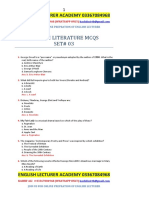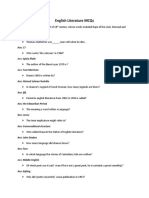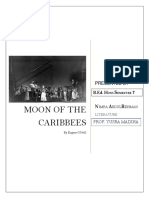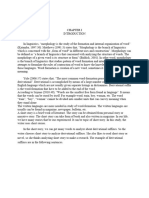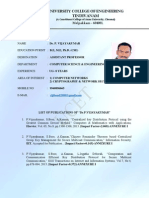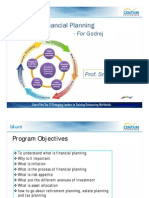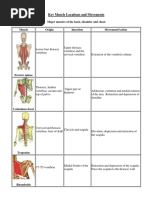Linguistic Terms
Linguistic Terms
Uploaded by
Muhammad ArifCopyright:
Available Formats
Linguistic Terms
Linguistic Terms
Uploaded by
Muhammad ArifOriginal Description:
Copyright
Available Formats
Share this document
Did you find this document useful?
Is this content inappropriate?
Copyright:
Available Formats
Linguistic Terms
Linguistic Terms
Uploaded by
Muhammad ArifCopyright:
Available Formats
LINGUISTICS TERMS
1. Language. It is a system of conventional, spoken or written symbols by means of
which human beings, as the members of a social group and participant in its culture
communicate (OR). It is a primarily human and non instinctive method of
communicating ideas, emotions and dresses by means of a system of voluntarily
produced symbols.
2. Linguistics. It is the science that studies the origin, organization, nature and
development of a language descriptively, historically comparatively and formulates
the general rules related to language.
3. Diachronic Linguistics. It is the linguistics that studies the development of
language through history or through time.
4. Synchronic Linguistics. It is the linguistics that investigates how the people
speak and use language in a given speech community at a given time.
5. Comparative Linguistics. It is the linguistics through which two or more different
languages are compared.
6. Langue. It is the set of all possible grammatical sentences in the language.
7. Parole. It is the only object available for direct observation to the linguist.
Utterances are examples of parole.
8. Socio-Linguistics. The study of language as part of culture and society has now
commonly been accepted as socio- linguistics.
9. Psycho-Linguistics. It is the study of interrelationship of psychological and
linguistic behaviour.
10. Dialect. It is a specific form of a given language spoken in a certain locality or
geographic area.
11. Sociolect. It is a form of language, which is spoken by the members of a
particular group of stratum of a speech community.
12. Isogloss. It is a line indicating the degree of linguistic change.
13. Registers. These are the varieties of language that correspond to different
situations, different speakers and listeners and writers and readers etc.(It is
business language of a particular profession)
14. Idiolect. It is a variety of language used by one individual speaker, including
peculiarities of pronunciation, grammar, vocabulary etc.
15. Diglossia. Where we do find two or more dialects or languages in regular use in
a community we have a situation which is called diglossia.
16. Pidgin. It is a contract language, a mixture of elements from different natural
Written & Composed by SAEED QURESHI M.A English (part 1) Page 1
LINGUISTICS TERMS
languages.
17. Creole, It is a mixed natural language composed of elements of different
languages in areas of intensive contact.
18. Phonetics. It is the scientific study of the production, transmission and reception
of speech sounds.
19. Acoustic Phonetics. It is the study of the physical properties of speech
sounds such as frequency and amplitude in their transmission.
20. Auditory Phonetics. It is the study of hearing and the perception of speech
sounds. It studies different auditory impressions of quality pitch and loudness of
sounds.
21. Articulatory Phonetics. It recognises that speech is produced by some kind of
sound making apparatus inside the human body and that specific sounds may be
related to specific movement of the apparatus.
22. Vowel. A word which is uttered without a blockage of air is called vowel.
23. Consonant. A word that cannot be spoken with out a blockage of air is called
consonant.
24. Stress. It is the degree of force with which a syllable or a word is uttered. It is
crucial in English pronunciation. It can be called grammatical device in spoken
English.
25. Intonation. It is the tune, the melody, the music of speech. It shows the
speaker’s mental attitude.
26. Phonology. It is the organization of sounds into patterns. It is the study of vocal
sounds and sound changes, phonemes and their variations in particular language.
27. Phoneme. It is the minimal bundle of relevant sound features.
28. Allophone. It is a speech sound which is one of a number of variants of a
phoneme. Such a variant can be either in complementary variation or in free
variation.
29. Morphology. It is the science and study of the smallest grammatical units
of language and of their formation into words including infection, derivation and
composition.
30. Syntax. It is the grammar of sentences and morphology is the grammar of
words.
31. Morpheme. Minimal units of grammatical structure such as the four components
of “un-faith – ful – ness” are called morphemes.
Written & Composed by SAEED QURESHI M.A English (part 1) Page 2
LINGUISTICS TERMS
32. Lexical Morphemes. These are nouns, verbs adjectives and adverbs.
33. Grammatical Morphemes. These are elements like prepositions, articles,
conjunctions, gender or tense and so on.
34. Compounds. A compound is lexical unit in which two or more lexical
morphemes are juxtaposed (contiguous / placed side by side) eg. Air craft, text book.
35. Idiom. An idiom is a phrase, the meaning of which cannot be predicted from the
individual meanings of morphemes it comprises.
36. Sentence. A sentence is a word or set of words followed by a phrase and
revealing on intelligible purpose.
37. Word. It may be defined as the union of a particular meaning with a particular
complex of sounds capable for a particular grammatical employment.
38. Analogy. It is process by which morphs, combination of morphs or linguistic
pattern are modified or new ones created in accordance with those present in a
language.
39. Stylistic. It is the study of linguistic features of a literary text – phonological,
lexical, syntactical which directly affects the meaning of an utterance.
40. Phrases. A group of words which is grammatically equivalent to a single word
and which does not have its own subject and predicate is called a phrase.
Written & Composed by SAEED QURESHI M.A English (part 1) Page 3
You might also like
- Applied Linguistics MCQs Final TermDocument8 pagesApplied Linguistics MCQs Final Termmohammad ahmad100% (1)
- Linguistics NotesDocument84 pagesLinguistics Notesmadunandan100% (2)
- MCQS Bank 3 (Literature)Document18 pagesMCQS Bank 3 (Literature)Farukh Mithabha100% (1)
- Sample Test For PHD Linguistics Entry TestDocument6 pagesSample Test For PHD Linguistics Entry TestMuhammadAsif100% (2)
- Symbolism in Frost's PoemsDocument2 pagesSymbolism in Frost's PoemsMuhammad ArifNo ratings yet
- MCQS LinguisticsDocument26 pagesMCQS LinguisticsfarahNo ratings yet
- Practice Test For LinguisticsDocument11 pagesPractice Test For LinguisticsKent Boyd ConcepcionNo ratings yet
- Language and Linguistics Solved MCQs (Set-2)Document6 pagesLanguage and Linguistics Solved MCQs (Set-2)Rai Zia Ur Rahman100% (1)
- Mam Samina File MCQS SemanticsDocument67 pagesMam Samina File MCQS SemanticsDua RazaNo ratings yet
- E4introducing Lang and Lit MCQ 200 QuestionsDocument34 pagesE4introducing Lang and Lit MCQ 200 QuestionsZahidaWaseemNo ratings yet
- 12-Linguistics Questions With Short Answers PDF For All ExamsDocument24 pages12-Linguistics Questions With Short Answers PDF For All ExamsSushil BhatNo ratings yet
- MCQ-1 FinalDocument3 pagesMCQ-1 FinalNipun Gupta100% (1)
- Part 4 Linguistics MCQs by Sajjad HaiderDocument12 pagesPart 4 Linguistics MCQs by Sajjad HaiderAman Alvi69% (26)
- Translation Studies MCQs Eng 8thDocument15 pagesTranslation Studies MCQs Eng 8thShahzadi AqsaNo ratings yet
- Part 2english Literature MCQS by Sajjad HiaderDocument9 pagesPart 2english Literature MCQS by Sajjad Hiaderwaqar aliNo ratings yet
- A Sociolinguistic Study On Diminishing Features of Saraiki LexiconDocument11 pagesA Sociolinguistic Study On Diminishing Features of Saraiki Lexiconaaaliya7777No ratings yet
- Literary Criticism and Theory Solved MCQs (Set-6)Document6 pagesLiterary Criticism and Theory Solved MCQs (Set-6)Omar MamdouhNo ratings yet
- 02-English Literature MCQs Set-02Document23 pages02-English Literature MCQs Set-02Maria NajamNo ratings yet
- Part 6 Linguistics MCQs by Sajjad HaiderDocument9 pagesPart 6 Linguistics MCQs by Sajjad HaiderSyed Ali Waqar HashmiNo ratings yet
- Phonology McqsDocument3 pagesPhonology Mcqsالاستاذ محمد زغيرNo ratings yet
- English Literature MCQsDocument6 pagesEnglish Literature MCQsHassan BalochNo ratings yet
- Pakistani English Literature Mcqs PDF Notes For Written Exams, Screening Tests and InterviewsDocument7 pagesPakistani English Literature Mcqs PDF Notes For Written Exams, Screening Tests and InterviewsAlia GulNo ratings yet
- Corpus Linguistics MCQs Eng 6thDocument12 pagesCorpus Linguistics MCQs Eng 6thShahzadi Aqsa100% (1)
- Articulator ProgramDocument6 pagesArticulator ProgramArga AnggaraNo ratings yet
- Moon of The Caribbees: Presented byDocument7 pagesMoon of The Caribbees: Presented byNim RaNo ratings yet
- PPSC Lecturer English Past Paper 2015 (Question)Document14 pagesPPSC Lecturer English Past Paper 2015 (Question)ALI SHER HaidriNo ratings yet
- Mcqs Discourse 11Document1 pageMcqs Discourse 11Khurram Malik80% (5)
- English Lecturer PPSC - Solved PaperDocument7 pagesEnglish Lecturer PPSC - Solved PaperTariq Mehmood0% (1)
- Contrastive PhonologyDocument8 pagesContrastive Phonologysundas zia100% (1)
- Pop MCQsDocument6 pagesPop MCQsMohsin Iftikhar100% (5)
- English Literature - 2013Document4 pagesEnglish Literature - 2013Jawad Ur Rehman Bhutta67% (3)
- BS English Syllabus GCU FSDDocument11 pagesBS English Syllabus GCU FSDTariq0% (1)
- MCQS Bank 4 (Literature)Document20 pagesMCQS Bank 4 (Literature)Farukh Mithabha0% (1)
- Hamlet MCQ 2Document2 pagesHamlet MCQ 2Sujatha Menon100% (1)
- FPSC English Lecturer (Drama)Document37 pagesFPSC English Lecturer (Drama)Muhammad Ismail Memon Jr.No ratings yet
- English Linguistics Mcqs With Answers PDF NotesDocument41 pagesEnglish Linguistics Mcqs With Answers PDF Notestayyab rehmanNo ratings yet
- Sample Paper GAT (G) NDU Mphil SP 2022Document5 pagesSample Paper GAT (G) NDU Mphil SP 2022Ali Asghar RindNo ratings yet
- English Mcqs For Public Service Commission Lecturers' TestDocument7 pagesEnglish Mcqs For Public Service Commission Lecturers' TestHussain BakshNo ratings yet
- Multiple Choice Questions Literary Criticism and TheoryDocument17 pagesMultiple Choice Questions Literary Criticism and TheoryTariq Aziz100% (6)
- Specimen MCQ Optional English-IDocument5 pagesSpecimen MCQ Optional English-IulhasvasantkadamNo ratings yet
- Eng Lit MCQDocument94 pagesEng Lit MCQnaveedmbaitNo ratings yet
- XH-C2: English (60 Marks) Q1. To Q 12. Are MCQ Where Only One Answer Is Correct. Each Question Carries One MarkDocument16 pagesXH-C2: English (60 Marks) Q1. To Q 12. Are MCQ Where Only One Answer Is Correct. Each Question Carries One MarkMegha BlueskyNo ratings yet
- 50 Solved MCQS ENglish LiteratureDocument5 pages50 Solved MCQS ENglish LiteratureSana Khan100% (1)
- BS 4 Romantic and Victorian PoetryDocument1 pageBS 4 Romantic and Victorian PoetrymarviNo ratings yet
- LinguisticsDocument81 pagesLinguisticsAltaf Hussain Shah100% (3)
- Solved Mcqus PART2Document29 pagesSolved Mcqus PART2AsmaNo ratings yet
- American Literature MCQ 1Document37 pagesAmerican Literature MCQ 1Bhavya KhannaNo ratings yet
- English Literature MCQsDocument42 pagesEnglish Literature MCQsD Sathish Kumar100% (4)
- MCQ English Literature With Answers 1Document117 pagesMCQ English Literature With Answers 1pushpNo ratings yet
- Prose McqsDocument12 pagesProse McqsBint e AshrafNo ratings yet
- Introduction To Literary Studies ADP 4th Semester Final PaperDocument3 pagesIntroduction To Literary Studies ADP 4th Semester Final PaperBen Ayşe100% (1)
- Possible MCQs of To The LighthouseDocument12 pagesPossible MCQs of To The LighthouseNoor Ul Ain80% (5)
- Elce Print OriginalDocument116 pagesElce Print OriginalArijith Reddy JNo ratings yet
- Dictionary Linguistic IntroducctionDocument5 pagesDictionary Linguistic IntroducctionEneyda QuinteroNo ratings yet
- Handouts Els 102 LESSON 1Document2 pagesHandouts Els 102 LESSON 1Jule BelzaNo ratings yet
- Language Is A System of CommunicationDocument8 pagesLanguage Is A System of CommunicationVanessa Ives™No ratings yet
- ITLReview - Yuli Mulyati PBI III B 2042300051Document6 pagesITLReview - Yuli Mulyati PBI III B 2042300051Dewi SafiraNo ratings yet
- I-MA-,Language and LinguisticsDocument9 pagesI-MA-,Language and LinguisticsBABADEMBA MANDIANGNo ratings yet
- Eng502 Glossary by Asfand YarrDocument15 pagesEng502 Glossary by Asfand Yarrsidnoor580No ratings yet
- LinguisticsDocument6 pagesLinguisticsNur Ain HasmaNo ratings yet
- Overview of English Linguistics CompilationDocument10 pagesOverview of English Linguistics CompilationIta Moralia RaharjoNo ratings yet
- Eliot As A CriticDocument2 pagesEliot As A CriticMuhammad ArifNo ratings yet
- The Theme of The Prologue OkDocument3 pagesThe Theme of The Prologue OkMuhammad Arif100% (1)
- Summary Gracian UrnDocument3 pagesSummary Gracian UrnMuhammad ArifNo ratings yet
- Chaucer RealismDocument3 pagesChaucer RealismMuhammad Arif100% (3)
- Chaucer's HumourDocument4 pagesChaucer's HumourMuhammad Arif100% (4)
- The Wretched of The Earth Summary and Analysis of Chapter 3Document3 pagesThe Wretched of The Earth Summary and Analysis of Chapter 3Muhammad Arif100% (1)
- Postcolonial LiteratureDocument3 pagesPostcolonial LiteratureMuhammad Arif100% (1)
- Frantz Fanon & Wretched of The EarthDocument4 pagesFrantz Fanon & Wretched of The EarthMuhammad Arif100% (1)
- Vijay KumarDocument4 pagesVijay Kumarbhuvi2312No ratings yet
- Hodder Checkpoint SpreadDocument18 pagesHodder Checkpoint SpreadDewa Sudiatmika100% (1)
- Financial Planning GodrejDocument199 pagesFinancial Planning GodrejriteshnaikNo ratings yet
- Test 10d IntensivDocument4 pagesTest 10d IntensivAnca GheorghitaNo ratings yet
- R. Watford DLP Assignment 1Document22 pagesR. Watford DLP Assignment 1rtwatforNo ratings yet
- Key Muscle Locations and MovementsDocument6 pagesKey Muscle Locations and Movementsmamun31100% (1)
- Yajur Veda Sandhya VandanamDocument16 pagesYajur Veda Sandhya Vandanamsuresh.srinivasnNo ratings yet
- Financial Economics Bodie Merton PresentationDocument5 pagesFinancial Economics Bodie Merton PresentationPaul Cheslaw0% (1)
- Learning Disabilities - DYSPRAXIADocument2 pagesLearning Disabilities - DYSPRAXIAAnnah Caponpon GalorNo ratings yet
- Jewish Standard, Nov. 29, 2013Document44 pagesJewish Standard, Nov. 29, 2013Larry YudelsonNo ratings yet
- Market Oriented EthnographyDocument22 pagesMarket Oriented EthnographyGabriel DobarceanuNo ratings yet
- CA Assignment No. 5 Part 1 ABC and Joint CostingDocument15 pagesCA Assignment No. 5 Part 1 ABC and Joint CostingMethlyNo ratings yet
- Pulse of The Profession (2020) - PMIDocument17 pagesPulse of The Profession (2020) - PMIIng. Ricardo CeballosNo ratings yet
- Joint Variation Day 3 1Document21 pagesJoint Variation Day 3 1maryabenoja29No ratings yet
- Easy Kitten With Heart Amigurumi PDF Free PatternDocument6 pagesEasy Kitten With Heart Amigurumi PDF Free PatternSandra100% (1)
- C1 Advanced - Extra ActivityDocument2 pagesC1 Advanced - Extra ActivityRamon LimaNo ratings yet
- Adders: Cmos Vlsi Design Cmos Vlsi DesignDocument160 pagesAdders: Cmos Vlsi Design Cmos Vlsi DesignSudhan KrishNo ratings yet
- Read The Tale and Answer The Questions: © 2013. - All Rights ReservedDocument2 pagesRead The Tale and Answer The Questions: © 2013. - All Rights ReservedVikneshVeginNo ratings yet
- Lesson 3 Conducting Market Analysis For Franchising SubjectDocument16 pagesLesson 3 Conducting Market Analysis For Franchising SubjectJengky PabuayaNo ratings yet
- Group 2 Parental InvolvementDocument28 pagesGroup 2 Parental InvolvementDainielle BianzonNo ratings yet
- The Christmas VillageDocument39 pagesThe Christmas VillageVictoria ButtaroNo ratings yet
- BOIVIN PILGRIMAGEENVIRONMENT 2021 CompressedDocument45 pagesBOIVIN PILGRIMAGEENVIRONMENT 2021 Compressedmattfurly2194No ratings yet
- Milktea Case Study: Group 1 Final Round MinicaseDocument24 pagesMilktea Case Study: Group 1 Final Round MinicaseHải ĐăngNo ratings yet
- Đề cương ôn tập học kì 1 môn Tiếng Anh lớp 11 Trường THPT Trần Phú - Hoàn Kiếm năm 2021 - 2022Document6 pagesĐề cương ôn tập học kì 1 môn Tiếng Anh lớp 11 Trường THPT Trần Phú - Hoàn Kiếm năm 2021 - 2022Hang Nguyen MinhNo ratings yet
- Proposal UBS Case StudyDocument6 pagesProposal UBS Case StudyAritra BhowmikNo ratings yet
- Chapter 2Document11 pagesChapter 2Veronica BaileyNo ratings yet
- Ants Lesson PlanDocument4 pagesAnts Lesson Planapi-264036251No ratings yet
- CCNP R&S SWITCH 300-115 Foundation Learning Guide-130-208Document79 pagesCCNP R&S SWITCH 300-115 Foundation Learning Guide-130-208eduar marinNo ratings yet
- Be A Change Maker With A Strong HeartDocument2 pagesBe A Change Maker With A Strong Heartgrace ranqapulioNo ratings yet
- Mahatma Gandhi and Nature CureDocument4 pagesMahatma Gandhi and Nature CurekeerthhikaNo ratings yet


